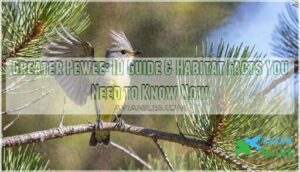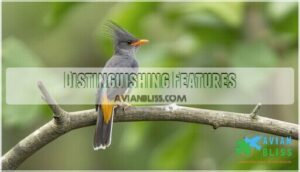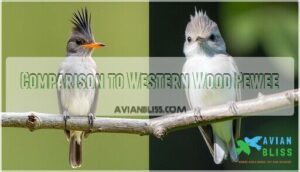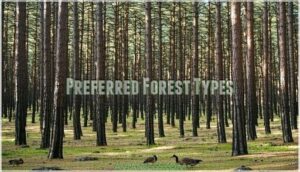This site is supported by our readers. We may earn a commission, at no cost to you, if you purchase through links.
 You’ll recognize a greater pewee by its distinctive crested head and grayish-brown plumage with a pale yellowish belly.
You’ll recognize a greater pewee by its distinctive crested head and grayish-brown plumage with a pale yellowish belly.
This chunky flycatcher perches boldly on exposed branches in pine and pine-oak forests throughout the southwestern U.S. and Mexico.
Unlike its smaller wood-pewee cousins, it’s got a longer bill and that unmistakable "Jose Maria" call that echoes through mountain conifers.
You’ll find these acrobatic insect-catchers mainly at higher elevations, where they launch from their perches to snag flying prey with impressive precision.
Their mountain specialist lifestyle and jaunty crest make them surprisingly easy to spot once you know their preferred haunts and signature behaviors.
Table Of Contents
- Key Takeaways
- Greater Pewee Identification
- Greater Pewee Habitat
- Greater Pewee Behavior
- Greater Pewee Breeding
- Greater Pewee Conservation
- Frequently Asked Questions (FAQs)
- How big are the greater Pewee?
- What is the difference between Phoebe and pewee?
- How do you identify a western wood pewee?
- Is a pewee a flycatcher?
- Is a towhee bigger than a robin?
- What is the wingspan of the Eastern Wood Pewee?
- What does a greater pewee look like?
- Where does a greater pewee live?
- What is a greater pewee flycatcher?
- What does a greater pewee eat?
- Conclusion
Key Takeaways
- You’ll identify greater pewees by their distinctive spiky crest, bright orange lower mandible, and larger size compared to similar wood-pewees – they’re 7-8 inches long with plain olive-gray plumage.
- You’ll find these mountain specialists in pine and pine-oak forests at elevations around 6,000 feet across Arizona and western New Mexico, where they perch on exposed branches to hunt insects.
- You’ll hear their unmistakable "José María" call echoing through conifer forests – this signature vocalization distinguishes them from other flycatcher species that produce different sounds.
- You’ll watch them demonstrate impressive aerial hunting skills as they launch up to 50 feet from their perches to snatch flying insects with precision before returning to the same lookout spot.
Greater Pewee Identification
You’ll recognize the Greater Pewee by its plain olive-gray plumage, distinctive spiky crest, and bright orange lower mandible that sets it apart from other flycatchers.
This medium-sized bird measures 7-8 inches long and appears noticeably larger and darker than the similar Western Wood-Pewee, with more pronounced cresting and a longer, more pointed bill.
Physical Characteristics
In terms of bird size becomes regarding bird size, and notably becomes remarkably.
Regarding bird size, you’ll spot a Greater Pewee measuring 7-8 inches with distinctive gray feather color throughout.
Here’s what catches your eye:
- Crest size: Short, spiky tuft creating triangular head profile
- Beak shape: Long, pointed bill with bright orange lower mandible
- Tail length: Remarkably long with square, notched tip
- Wing bars: Faint, indistinct markings on wings
- Overall build: Sturdy frame weighing 22-36 grams between sparrow-robin size
The Greater Pewee can be identified by its unique characteristics, often found in montane pine forests.
Distinguishing Features
You’ll easily spot a Greater Pewee by its distinctive crest shape—short and spiky, unlike smoother-headed flycatchers.
The bill color stands out with its bright orange lower mandible contrasting against the dark upper beak. The plumage pattern stays uniformly olive-gray without bold markings, while the beak size appears remarkably long and pointed for effective insect catching.
The tail notch appears square-tipped or slightly notched. The Eastern Wood Pewee’s bird migration patterns can help identify similar species and their habitats, using effective insect catching techniques and observing the plumage pattern.
Comparison to Western Wood Pewee
You’ll often confuse these flycatcher species without knowing key differences.
The greater pewee stands out as the larger, more robust bird with distinctive features that separate it from its smaller cousin.
Here’s how to tell them apart:
- Size difference: Greater pewees measure 7-7¾ inches versus the smaller Western Wood-Pewee
- Beak color: Look for the greater pewee’s bright orange lower mandible contrasting with dark upper parts
- Crest shape: Greater pewees sport a spiky, tufted crest that Western Wood-Pewees lack entirely
- Plumage tone: Greater pewees appear darker and more olive-gray compared to their paler relatives
The pewee song also differs substantially—greater pewees deliver their famous "Jo-se-Ma-ri-a" call while Western Wood-Pewees produce a descending "pee-a-wee" whistle.
These bird identification markers make distinguishing between these flycatcher species much easier in the field.
Greater Pewee Habitat
You’ll find Greater Pewees in the mountainous pine and pine-oak forests of Arizona and western New Mexico during summer months.
These birds prefer elevations around 6,000 feet, where they perch high in mature pines and sycamores to hunt for flying insects.
Geographical Range
You’ll find Greater Pewees across mountain habitats from southeastern Arizona and southwestern New Mexico down through Mexico to Nicaragua.
Their regional distribution patterns in Forest Ecosystems, with northern populations following specific migration routes between breeding and wintering grounds, are notable.
The pewee range centers on southwestern US terrain features, making bird migration tracking easier for birders exploring Mexico’s diverse landscapes.
Preferred Forest Types
You’ll find Greater Pewees thriving in pine-oak forests where towering Ponderosa pines mix with sturdy oak understories.
These mountain forests provide the perfect blend—open canopies for aerial hunting and dense tree species for nesting.
The birds prefer mature woodlands with scattered understory, creating ideal breeding habitat within these complex forest ecosystems.
They typically inhabit areas with suitable pine tree habitats that support their nesting and foraging needs.
Elevation and Breeding Grounds
You’ll discover Greater Pewees thriving in mountainous habitat between 3,000-11,200 feet elevation.
These birds choose breeding elevations around 6,000 feet, where dense pineoak forests provide perfect nesting conditions unlike the Western WoodPewee’s lower terrain preferences.
- Mountain Habitats: Southeastern Arizona and western New Mexico peaks
- Forest Density: Dense pine and oak canopies with scattered understory
- Breeding Elevations: Middle elevations averaging 6,000 feet above sea level
- Nesting Heights: Branch forks 10-40 feet high in mature pines
Understanding their woodland habitat is essential for effective birdwatching and conservation efforts.
Greater Pewee Behavior
You’ll notice Greater Pewees are patient hunters that perch high in pine trees, scanning for flying insects with remarkable focus.
They’re acrobatic fliers that can snatch prey up to 50 feet away before returning to their favorite lookout spot.
Foraging Techniques
You’ll watch Greater Pewees master their aerial hunts from high pine perches.
These insectivorous experts use classic perch foraging, scanning for flying insects before launching acrobatic sallies up to 50 feet away.
Their flying tactics involve swift captures followed by returns to the same exposed branch.
This hawking technique makes insect capture look effortless as they dominate their food sources through patient observation and precise bird behavior.
To fully appreciate these birds, understanding the right bird watching gear is essential for effective observation, utilizing the best methods for patient observation.
Diet Composition
Flying insects dominate the pewee diet, comprising over 80% of their meals during breeding season.
You’ll spot them hawking beetles, wasps, bees, and flying ants through aerial foraging techniques.
Their insectivorous nature shifts seasonally—fruit consumption increases to 15% in late summer when insect capture becomes harder, showing remarkable dietary variation.
The pewee’s dietary needs can be supported with proper bird food supplements.
Social Interactions and Flocking
Greater Pewees occasionally join mixed-species feeding flocks during non-breeding seasons, creating fascinating group dynamics among tyrant flycatchers and other bird species.
You’ll witness territorial interactions when conspecifics compete for prime perches, and this flocking behavior offers social learning opportunities, though pewees remain primarily solitary.
Bird communication through calls helps maintain spacing, and understanding these social interactions enhances your birdwatching guide experience substantially.
Greater Pewee Breeding
You’ll find Greater Pewees are surprisingly dedicated parents who take their breeding responsibilities seriously.
These mountain flycatchers create sturdy nests in pine forks and fiercely defend their territory against much larger predators.
Nesting Sites and Construction
Finding the perfect spot isn’t just luck – Greater Pewees are master architects with specific tree selection criteria.
These skilled builders choose horizontal branches 10-40 feet high in mature pines, sycamores, or oaks, creating cup-shaped nests from grass, weeds, and plant fibers lined with fine materials.
- Tree Selection: Prefers tall pines, sycamores, and oak trees for ideal nest placement
- Branch Preference: Selects sturdy horizontal branches with natural fork formations for stability
- Nest Architecture: Builds open cup-shaped structures using interwoven grass and plant fibers
- Nest Materials: Incorporates pine needles, bark strips, spider silk, and camouflaging lichens
- Construction Techniques: Female weaves materials together, creating weather-resistant bird nesting sites
The Greater Pewee’s nesting strategy involves careful consideration of nesting site factors to guarantee the survival of its offspring.
Clutch Size and Incubation
How many eggs will you find in a Greater Pewee’s nest? Most clutches contain 3-4 creamy white eggs with light brown speckling.
The female handles incubation alone for 14-16 days, rarely leaving her nest during daylight hours. Harsh mountain weather can extend the incubation period beyond typical timing, affecting breeding behavior and nest site success.
Understanding the role of bird egg products is vital for conservation efforts.
Parental Care and Territorial Defense
Both parents work as a team in brood care, with females handling most incubation duties while males assist in feeding nestlings.
Greater Pewee parents are devoted partners—mom incubates while dad brings home dinner for their growing family.
These fierce defenders don’t mess around in matters of nest defense – they’ll aggressively chase away jays, woodpeckers, and even squirrels that dare approach their territory.
Their territorial marking through vocal displays and aerial pursuits creates safe nesting zones that smaller bird species often exploit for predator avoidance benefits.
Greater Pewee Conservation
Understanding conservation efforts helps protect Greater Pewees for future birdwatchers like you. These birds face unique challenges across their mountain forest range that require ongoing research and habitat management.
Migration Patterns
You’ll discover that Greater Pewees aren’t long-distance champions like other songbirds.
These short-distance migrants follow predictable seasonal movements within their mountain strongholds.
Migration patterns include:
- Flyway Routes: Move along western mountain corridors from Arizona to Central America
- Altitude Changes: Drop from breeding elevations to lower wintering grounds
- Seasonal Movements: Northern birds migrate south while southern populations stay put year-round
- Stopover Sites: Use oak woodlands and riparian areas during transit
- Wintering Grounds: Settle in Mexican pine-oak forests and Central American highlands
Conservation Status and Threats
You’ll find the Greater Pewee holds IUCN Least Concern conservation status with roughly 2 million individuals worldwide.
However, bird conservation faces mounting pressures from Habitat Loss through logging and agriculture conversion.
Climate Change threatens forest composition while Pollution Effects impact insect prey availability.
Human Impact includes fire suppression disrupting natural cycles, and Fragmentation Risks reduce genetic diversity, requiring ongoing monitoring efforts.
Taxonomy and Subspecies Variation
Understanding Species Classification within Genus Contopus reveals fascinating Taxonomic History.
Greater Pewee’s scientific name Contopus pertinax belongs to Tyrannidae family, order Passeriformes.
You’ll find six recognized subspecies showing Subspecies Variation across ranges.
The pertinax subspecies occurs in southwestern US, while minor inhabits Central America.
Flycatcher Evolution studies confirm this species’ distinct lineage, though identification challenges persist with related pewees.
The eastern wood pewee exhibits unique woodland habitat characteristics that distinguish it from other flycatchers.
Frequently Asked Questions (FAQs)
How big are the greater Pewee?
You’ll find Greater Pewees measure 7-7¾ inches long, weighing between 78-3 ounces.
They’re noticeably larger than Western Wood-Pewees, with their distinctive spiky crest and orange lower bill making them stand out.
What is the difference between Phoebe and pewee?
You’ll spot these cousins apart easier than you’d think.
Phoebes have dark brown heads contrasting with white throats, while pewees are grayer overall with stronger wingbars.
Phoebes wag their tails constantly—a dead giveaway.
How do you identify a western wood pewee?
Look for a small, plain grayish-brown flycatcher with subtle wing bars, no eye ring, and a slightly notched tail. You’ll hear its distinctive "pee-wee" call echoing through western woodlands.
Is a pewee a flycatcher?
Yes, pewees are flycatchers in the Tyrannidae family.
They are recognized by their insect-catching behavior – they perch openly, then dart out to snag flying insects before returning to the same spot.
Is a towhee bigger than a robin?
Like comparing apples and oranges in a bird’s nest, you’ll find towhees are smaller than robins.
Both Eastern and Spotted Towhees are roughly robin-sized but actually smaller than the familiar American Robin.
What is the wingspan of the Eastern Wood Pewee?
You’ll find the Eastern Wood Pewee’s wingspan measures 1 to 2 inches (23-26 cm) . These small flycatchers possess proportionally long wings that help them catch insects during their aerial sallies from perches.
What does a greater pewee look like?
You’ll recognize this plain gray flycatcher by its distinctive spiky crest and bright orange lower mandible. It’s larger than similar wood-pewees, with faint wing bars and a notched tail.
Where does a greater pewee live?
Mountain retreats become your best bet for spotting these birds.
You’ll find greater pewees in pine and pine-oak forests across Arizona’s mountains and western New Mexico, typically perching around 6,000 feet elevation during summer months, which is a key factor for spotting these birds.
What is a greater pewee flycatcher?
A Greater Pewee flycatcher is a gray, crested songbird that hunts flying insects from tall pine perches.
You’ll recognize its distinctive orange lower bill and hear its famous "José María" whistle echoing through southwestern mountain forests.
What does a greater pewee eat?
You’ll spot these aerial acrobats snatching flying insects mid-flight from their high perches in pine trees.
They’ll catch beetles, flies, and moths up to fifty feet away, returning to the same branch after each hunting sortie.
Conclusion
Mastering greater pewee identification transforms challenging mountain birding into rewarding discoveries.
You’ll confidently distinguish this crested flycatcher from similar species using key field marks like its sturdy bill, yellowish belly, and distinctive "Jose Maria" call.
Understanding their preferred pine-oak habitats at higher elevations helps predict encounters during hiking adventures.
These impressive insect hunters face ongoing conservation challenges from habitat loss and climate change.
By recognizing greater pewee characteristics and behaviors, you’re contributing to citizen science efforts that support their long-term survival across southwestern mountain ecosystems.












